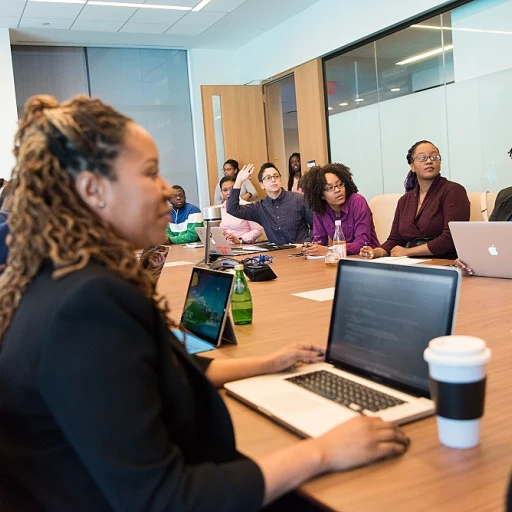Understanding the Role of a Human Capital Strategist
Defining the Responsibilities of a Human Capital Strategist
A human capital strategist plays a pivotal role in aligning an organization’s workforce goals with its overarching business strategy. The primary focus of this role is to optimize the use of human resources, thereby driving performance and contributing to the organization’s strategic objectives.- Strategic Vision and Mission Alignment: These professionals are tasked with integrating the company’s vision and mission into the talent management framework. This involves crafting strategies that ensure employees are motivated and engaged, ultimately leading to enhanced organizational performance.
- Talent Acquisition and Management: A human capital strategist is integral in designing and implementing strategies for attracting and retaining top talent. This includes developing programs for employee engagement and performance management that dovetail with the organization's strategic goals.
- Change Management: Navigating change is a significant aspect of this role. Human capital strategists develop change management frameworks that facilitate smooth transitions during shifts in business strategy, ensuring minimal disruption to employee performance.
- Performance Optimization: Strategic oversight of performance management systems is crucial. These experts work on creating performance metrics to track and evaluate the effectiveness of the workforce in meeting the organization’s goals objectives.
- Implementation of Best Practices: Crafting and implementing best practices in human capital management forms a core responsibility. This encompasses a wide range of activities from developing a total rewards program to enhancing employee engagement and improving talent retention strategies.
- Fostering an Innovative Culture: By promoting a culture of innovation, human capital strategists ensure that the workforce remains competitive and adaptive to changes. This not only supports the organization's long-term strategic objectives but also fuels its growth in competitive markets, especially in areas like the United States.
Essential Skills for Aspiring Human Capital Strategists
Key Competencies for Effective Human Capital Strategies
Aspiring human capital strategists need to hone a diverse set of skills to successfully navigate the complex landscape of human resources and organizational development. These professionals must integrate strategic objectives with day-to-day operations, ensuring that the workforce is aligned with the overall business strategy.- Talent Management: A deep understanding of talent management is crucial. Strategists must identify, recruit, and retain top talent while fostering an environment that promotes employee engagement and development.
- Change Management: In a rapidly evolving business environment, effective change management skills are essential. Human capital strategists must guide organizations through transitions, ensuring that employees adapt to new systems and processes seamlessly.
- Strategic Vision and Planning: Having a clear vision and the ability to develop a strategy framework that aligns with organizational goals is essential. This includes defining vision missions and setting strategic objectives that drive performance.
- Performance Management: Implementing effective performance management programs ensures that employees are held accountable and rewarded based on their contributions to business objectives.
- Analytical Skills: High proficiency in analyzing human capital data to inform strategic decisions is vital. This includes using metrics to assess workforce performance and identify areas for improvement.
- Communication and Interpersonal Skills: Effectively communicating strategic goals and engaging with various stakeholders, including employees, management, and external partners, is a fundamental requirement.
- Understanding of Organizational Behavior: A keen insight into how organizational cultures and structures impact employee performance and change initiatives is crucial for capital strategy development.
By mastering these competencies, human capital strategists can enhance their ability to implement best practices in capital management, thereby driving the organization toward achieving its strategic goals. As technology continues to shape the future of work, these skills will become increasingly vital for maintaining a competitive edge in any business environment, including small businesses in the United States.
Educational Pathways and Certifications
Academic and Certification Pathways to Success
Paving the path to becoming an adept human capital strategist involves a keen focus on education and acquiring relevant certifications. In this evolving field where organizational goals intersect with employee engagement and talent management, staying informed about the latest industry trends and best practices is essential. For those on the journey to becoming a human capital strategist, a bachelor's degree in human resource management, business administration, or a related field is often the foundational step. This formal education provides a solid grounding in the principles of managing human resources and capital, equipping aspiring strategists with understanding strategic objectives in alignment with business strategy. In addition to a degree, obtaining certifications can significantly bolster one’s qualifications. Certifications such as Senior Professional in Human Resources (SPHR), Global Professional in Human Resources (GPHR), or a strategic human capital management certification can be powerful assets, showcasing a deep knowledge of performance management, talent retention, and change management. Continuous learning is also crucial, given the shifts in the workforce and the emergence of technology impacting human capital strategies. Engaging in professional development programs, attending workshops, and participating in webinars related to HCM and capital strategy frameworks helps maintain a competitive edge. Expanding expertise beyond the classroom, involvement in real-world scenarios through internships, networking, and mentorship programs can offer valuable insights into managing change and aligning human resource strategies with an organization’s vision and mission. Aspiring strategists will find that their commitment to education and attainment of professional credentials not only enhance their understanding of strategic planning but also position them as valuable assets ready to drive organizational change and optimize employee performance. For those looking to craft a standout resume in pursuit of such opportunities, exploring CHRO resume crafting can provide essential insights into showcasing skills and experiences effectively in a competitive job market.Challenges Faced by Human Capital Strategists
Overcoming Obstacles in the Journey
For those pursuing a career as a human capital strategist, navigating the landscape of challenges is an essential aspect of growth. These challenges can range from aligning business strategy with human capital objectives to managing change within organizational structures. Understanding how these elements interact is crucial for effective strategy formulation and implementation.
One significant hurdle is the dynamic nature of talent management. A human capital strategist must continuously adapt strategies to address evolving workforce demographics and changing employee expectations. Effective talent management requires a balance between organizational goals and employee engagement.
Additionally, technological advancements are transforming how strategies are devised and executed. Human capital management (HCM) systems are revolutionizing performance management, allowing strategists to gain insights from data analytics. However, technology also brings complexities, requiring strategists to stay abreast of the latest developments and integrate them within a comprehensive strategy framework.
Another common challenge is coordinating diverse human resources (HR) programs aligned with the company’s vision and mission. Strategists should ensure that these programs enhance employee engagement and support the achievement of organizational goals. This requires an understanding of best practices and the ability to tailor them to specific business contexts.
Furthermore, in small business environments, limited resources can make it challenging to implement comprehensive human capital strategies. Strategists might need to prioritize certain elements while still ensuring alignment with strategic objectives. This calls for strategic thinking and innovative problem-solving.
Finally, change management is an ongoing challenge for human capital strategists. As organizations evolve, strategists must navigate the complexities of cultural shifts and workforce transitions to maintain high levels of performance and goal achievement.
Aspiring strategists should approach these challenges with a proactive mindset, continuously seeking opportunities for professional development and staying informed about the best strategies in human capital management.
Career Advancement Opportunities
Climbing the Human Capital Ladder
Embarking on a career as a human capital strategist presents numerous opportunities for growth and professional development. As the field is closely linked with human resources and talent management, progressing through different stages can pave the way for diverse experiences and exposure.
Developing Strategic Vision
Individuals in this role often transition from roles that demand strong expertise in human capital management and strategic formulation. To ascend to higher positions, it is critical to develop a keen eye for aligning employee and organizational goals, along with crafting strategies that drive performance and engagement.
Expanded Responsibilities
Once you’ve established a solid foundation, roles typically evolve to include broader responsibilities, such as overseeing talent management programs and leading change initiatives. Understanding performance management and employee engagement strategies is crucial for success in these roles.
Embrace Continuous Learning
Given the ever-changing landscape of business strategy and human capital management, staying updated with the latest trends and best practices is essential. Pursuing advanced certifications or even post-graduate education could be beneficial in distinguishing oneself within the workforce.
Potential Obstacles
While the prospects are vast, challenges such as navigating complex organizational structures, adapting to technological advancements, and addressing employee needs may arise. Successfully overcoming these challenges requires an agile mindset and a robust strategy framework.
Building a Strategic Network
Networking is a key component of career advancement. Establish relationships with leaders in your field, engage with professional communities, and learn from peers. This network can serve as a valuable resource when navigating the complexities of human capital strategy roles.
For those looking to excel, consistent dedication and a commitment to fostering a dynamic and innovative work environment will drive sustained progress in the career of a human capital strategist.
Impact of Technology on Human Capital Strategy
Technology's Influence on Human Capital Strategy
The landscape of human capital strategy is undergoing a significant transformation, largely driven by technological advancements. As a human capital strategist, understanding and leveraging these technologies is crucial for aligning with organizational goals and enhancing employee performance.
One major area of impact is Human Capital Management (HCM) systems. These platforms integrate various functions such as talent management, employee engagement, and performance management. By utilizing HCM systems, strategists can streamline processes and make data-driven decisions that align with the strategic objectives of the organization.
Another critical aspect is the role of analytics and big data. By harnessing data analytics, human capital strategists can gain insights into workforce trends, predict future needs, and optimize talent management strategies. This approach not only supports the organization's vision and mission but also enhances the overall employee experience by tailoring programs to meet their needs.
Embracing Change Management
With technology continually evolving, change management becomes an essential skill for human capital strategists. Implementing new technologies requires a strategic framework to ensure smooth transitions and minimize disruptions. Effective change management strategies help align the workforce with new systems, fostering a culture of adaptability and continuous improvement.
Moreover, technology enables the implementation of best practices in employee engagement and total rewards programs. By leveraging digital tools, strategists can design and execute initiatives that drive employee satisfaction and retention, ultimately supporting the business strategy and achieving strategic objectives.
In the United States and globally, the integration of technology into human capital management is not just a trend but a necessity for staying competitive. As organizations continue to evolve, the role of technology in shaping human capital strategy will only grow, making it an indispensable component of the modern strategist's toolkit.



